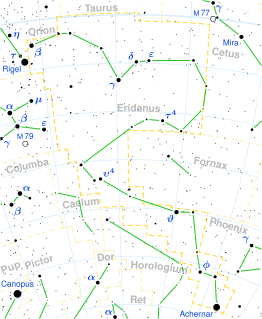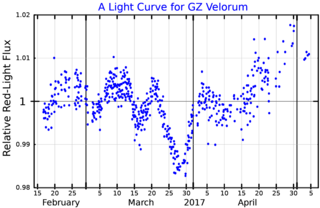Related Research Articles

θ Trianguli Australis, Latinized as Theta Trianguli Australis, is a single star in the southern constellation of Triangulum Australe. It is visible to the naked eye as a dim, yellow-hued star with an apparent visual magnitude of +5.50. The star is located about 334 light years from the Sun based on parallax, and is drifting further away with a radial velocity of +10 km/s.

Omega Andromedae is the Bayer designation for a slowly co-rotating binary star system in the northern constellation of Andromeda. Parallax measurements made during the Gaia mission make this system to be approximately 93.9 light-years from Earth. Its apparent visual magnitude is +4.83, which makes it bright enough to be seen with the naked eye.
65 Andromedae, abbreviated 65 And, is a single, orange-hued star in the northern constellation of Andromeda. With an apparent magnitude of 4.73, it is visible to the naked eye. The distance to 65 And can be derived from its annual parallax shift of 7.5 mas, which yields a range of around 440 light years. At that distance, its brightness is relatively lowered primarily by the inverse square law but also by an extinction of 0.16 magnitude due to interstellar dust. The star is moving closer to the Earth with a heliocentric radial velocity of −5 km/s.
6 Canis Minoris is a star in the equatorial constellation of Canis Minor, located around 570 light years away from the Sun. It is visible to the naked eye as a faint, orange-hued star with an apparent visual magnitude of +4.55. This object is moving closer to the Earth with a heliocentric radial velocity of −16.3 km/s. Kinematically, it is a member of an outlying group belonging to the Ursa Major flow of the Sirius supercluster.

Tau4 Eridani is a binary star system in the constellation Eridanus. It is visible to the naked eye with an apparent visual magnitude of 3.65. The distance to this star can be estimated using the parallax method, which yields a value of roughly 300 light years.

Tau Puppis, Latinized from τ Puppis, is a star in the southern constellation of Puppis, near the southern constellation boundary with Carina. It is visible to the naked with an apparent visual magnitude of +2.95 and is located at a distance of about 182 light-years from Earth. The variable radial velocity of this system was detected by H. D. Curtis and H. K. Palmer in 1908, based on observations made at the D. O. Mills Observatory. It is a spectroscopic binary star system, with the presence of the secondary component being revealed by the shifts of absorption lines in the spectrum resulting from the Doppler effect. The two components orbit each other with a period of 1,066.0 days and a low eccentricity of 0.090.
HD 197036 is a single star in the northern constellation Cygnus. It has an absolute magnitude of −1.15 and an apparent magnitude of 6.61, below the max naked eye visibility. Located 1,310 light years away, it is approaching Earth with a heliocentric radial velocity of −15 km/s.
HD 88809 is a star located in the southern constellation Antlia. With an apparent magnitude of 5.89 it is barely visible to the naked eye under ideal conditions. The star is located at a distance of around 451 light years but is drifting away at a heliocentric radial velocity of almost 20 km/s.
24 Vulpeculae is a single, yellow-hued star in the northern constellation of Vulpecula. It is faintly visible to the naked eye with an apparent visual magnitude of 5.30. The distance to this star can be estimated from its annual parallax shift of 7.9700±0.0674, which yields a separation of roughly 409 light years. It is moving further away with a heliocentric radial velocity of +15 km/s.
Lambda Mensae, Latinized from λ Mensae, is an orange-hued star in the southern constellation of Mensa. It has an apparent visual magnitude of 6.53, which places it at or near the limit on stars visible to the naked eye. According to the Bortle scale, it requires a dark night from rural skies for this star to be viewed. Though it has the designation Lambda, it is actually the twenty-fourth-brightest star in the constellation and not the eleventh-brightest.
HD 200661 is a solitary star in the equatorial constellation Equuleus. It has an apparent magnitude of 6.41, placing it near the max naked eye visibility. The star is situated at a distance of 430 light years but is approaching with a heliocentric radial velocity of −12.1 km/s.
HD 10550 is a single star in the equatorial constellation of Cetus. It is a faint star but visible to the naked eye with an apparent visual magnitude of 4.98. Based upon an annual parallax shift of 2.9564 mas, it is located around 1,100 light years from the Sun. The star is moving closer with a heliocentric radial velocity of −33 km/s. It has a high peculiar velocity of 72.7+5.7
−4.3 km/s and may be a runaway star.
HD 81799 is a suspected astrometric binary star system in the equatorial constellation of Hydra. It is visible to the naked eye with an apparent visual magnitude of 4.69. The distance to this system, as determined from an annual parallax shift of 19.9 mas, is 164 light years. It is moving further away from the Earth with a heliocentric radial velocity of 29 km/s. The system has a relatively high rate of proper motion, traversing the celestial sphere at the rate of 233±19 mas/yr along a position angle of 136°.

GZ Velorum is a single, orange-hued star in the southern constellation of Vela. It is a faint star but visible to the naked eye, having an apparent visual magnitude of 4.58. The star is located around 1,300 light years from Earth, as determined from its annual parallax shift of 2.4 mas. It is moving further away with a heliocentric radial velocity of +13 km/s.
HD 89998 is a single star in the southern constellation of Vela. It is a faint star but visible to the naked eye with an apparent visual magnitude of 4.82. The distance to HD 89998, as determined from its annual parallax shift of 15.9 mas, is 205 light years. The star is moving further from the Earth with a heliocentric radial velocity of +21 km/s, having come within 140 ly some 1.552 million years ago.
3 Piscis Austrini, also known as HD 201901, is a suspected astrometric binary star system that, despite its Flamsteed designation, is actually located in the constellation Microscopium. It is visible to the naked eye as a faint, orange-hued star with an apparent visual magnitude of 5.41. The system is moving closer to the Earth with a heliocentric radial velocity of −46 km/s. It is following a highly elliptical orbit around the Galactic Center, moving between a pericenter of 2.6 kpc out to an apocenter of 7.6 kpc, with an orbital eccentricity of 0.49.
HD 32515 is a solitary star located in the southern constellation Caelum. It has an apparent magnitude of 5.9, making it faintly visible to the naked eye under ideal conditions. The star is situated at a distance of 326 light years but is recceding with a heliocentric radial velocity of 29.4 km/s.
HD 166006 is a double star in the southern constellation Telescopium. With an apparent magnitude of around 6, it is barely visible to the naked eye under ideal conditions. The star is located 582 light-years based on parallax, but is drifting closer with a heliocentric radial velocity of 16.5 km/s.
Iota Octantis, Latinized, from ι Octantis is a double star in the southern circumpolar constellation Octans. The "A" component has an apparent magnitude of 5.83, making it faintly visible to the naked eye under ideal conditions, but the "B" component can't be seen due to its faintness. The system is located at a distance of 350 light years based on its annual parallax shift, but is drifting away at a rate of 53.4 km/s.
HD 196775 is a solitary star in the equatorial constellation Delphinus. It has an apparent magnitude of 5.98, allowing it to be faintly seen with the naked eye. The object is relatively far at a distance of 1,050 light years but is approaching the Solar System with a heliocentric radial velocity of −4.6 km/s. HD 196775 has a high peculiar velocity of 21.8+1.9
−4.1 km/s compared to neighboring stars, indicating that it may be a runaway star.
References
- 1 2 3 4 5 6 Brown, A. G. A.; et al. (Gaia collaboration) (2021). "Gaia Early Data Release 3: Summary of the contents and survey properties". Astronomy & Astrophysics . 649: A1. arXiv: 2012.01533 . Bibcode:2021A&A...649A...1G. doi: 10.1051/0004-6361/202039657 . S2CID 227254300. (Erratum: doi:10.1051/0004-6361/202039657e). Gaia EDR3 record for this source at VizieR.
- 1 2 Høg, E.; Fabricius, C.; Makarov, V. V.; Urban, S.; Corbin, T.; Wycoff, G.; Bastian, U.; Schwekendiek, P.; Wicenec, A. (March 2000). "The Tycho-2 catalogue of the 2.5 million brightest stars". Astronomy and Astrophysics. 355: L27–L30. Bibcode:2000A&A...355L..27H. ISSN 0004-6361.
- 1 2 Houk, N.; Cowley, A. P. (1975). University of Michigan Catalogue of two-dimensional spectral types for the HD stars. Volume I. Declinations -90_ to -53_ƒ0. Bibcode:1975mcts.book.....H.
- 1 2 Johnson, H. L.; Mitchell, R. I.; Iriarte, B.; Wisniewski, W. Z. (1966). "UBVRIJKL Photometry of the Bright Stars". Communications of the Lunar and Planetary Laboratory. 4: 99–110. Bibcode:1966CoLPL...4...99J.
- 1 2 Brown, A. G. A.; et al. (Gaia collaboration) (August 2018). "Gaia Data Release 2: Summary of the contents and survey properties". Astronomy & Astrophysics . 616. A1. arXiv: 1804.09365 . Bibcode: 2018A&A...616A...1G . doi: 10.1051/0004-6361/201833051 . Gaia DR2 record for this source at VizieR.
- 1 2 Anders, F.; et al. (1 August 2019). "Photo-astrometric distances, extinctions, and astrophysical parameters for Gaia DR2 stars brighter than G = 18". Astronomy and Astrophysics. 628: A94. arXiv: 1904.11302 . Bibcode:2019A&A...628A..94A. doi: 10.1051/0004-6361/201935765 . ISSN 0004-6361. S2CID 131780028.
- 1 2 Lang, Kenneth R. (2006). Astrophysical formulae. Astronomy and astrophysics library. Vol. 1 (3 ed.). Birkhäuser. ISBN 3-540-29692-1.. The radius (R*) is given by:
- 1 2 McDonald, I.; Zijlstra, A. A.; Watson, R. A. (2017). "Fundamental parameters and infrared excesses of Tycho-Gaia stars". Monthly Notices of the Royal Astronomical Society. 471 (1): 770. arXiv: 1706.02208 . Bibcode:2017MNRAS.471..770M. doi: 10.1093/mnras/stx1433 .
- 1 2 3 4 Lafrasse, Sylvain; Mella, Guillaume; Bonneau, Daniel; Duvert, Gilles; Delfosse, Xavier; Chesneau, Olivier; Chelli, Alain (16 July 2010). "Building the 'JMMC Stellar Diameters Catalog' using SearchCal". Optical and Infrared Interferometry II. Vol. 7734. pp. 77344E. arXiv: 1009.0137 . Bibcode:2010SPIE.7734E..4EL. doi:10.1117/12.857024. S2CID 32097037.
- 1 2 3 Eggen, O. J. (February 1994). "Evolved GK stars near the Sun. 2: The young disk population". The Astronomical Journal. 107: 594. Bibcode:1994AJ....107..594E. doi: 10.1086/116879 . ISSN 0004-6256.
- 1 2 De Medeiros, J. R.; Alves, S.; Udry, S.; Andersen, J.; Nordström, B.; Mayor, M. (January 2014). "A catalog of rotational and radial velocities for evolved stars: V. Southern stars⋆⋆⋆". Astronomy & Astrophysics. 561: A126. arXiv: 1312.3474 . Bibcode:2014A&A...561A.126D. doi: 10.1051/0004-6361/201220762 . ISSN 0004-6361.
